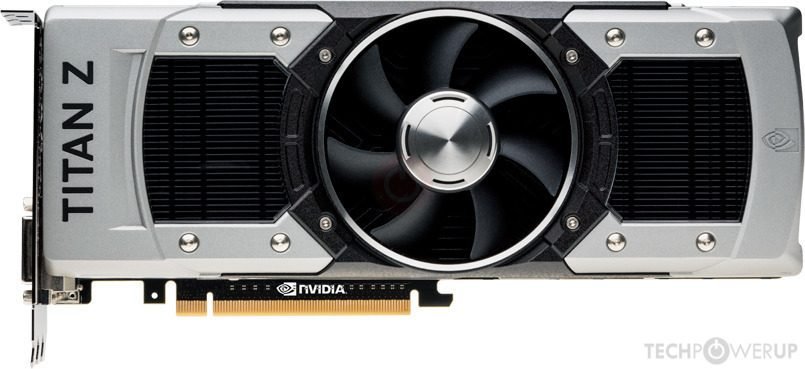As excited as we all get over big graphics card releases, we’ve seen a lot of really dumb products over the years. And I’m not just talking about cards with poor price or performance value or those really low-end models that basically serve as a glorified HDMI out. This thing can’t even run Solitaire. Today we’re going to look at a few cards that probably should never even have existed.
Nvidia Titan Z

Let’s start out with the infamous Titan Z from Nvidia, which came out in 2014.
This thing was a failure in terms of both marketing and overall execution. You see, the Titan series had, up until that point, been considered to straddle the line between a gaming card and a workstation card.
But the Titan Z was squarely marketed at gamers with Nvidia saying it was built for the most extreme PC gaming rigs. The thing cost $3,000, which put it out of reach even for gamers with deep pockets.
Not to mention it was basically just two GTX 780 Ti strapped together to form the weirdest, most unhealthy sandwich of all time. Buying two 780 Tis separately would have cost only one $1400. And buying a pair of Titan Blacks, which used the same GPU to get the same amount of VRAM as the Titan Z would have only cost $2,000.
To top it all off, performance was underwhelming due to long-standing issues with SLI, as well as the aging Kepler architecture. Meaning you paid a king’s ransom for a product that was quickly usurped by younger, sneakier members of the royal court.
AMD R9 Fury X
Let’s now look at a poorly marketed product from team red – the AMD R9 Fury X from 2015. At the time, Nvidia had a more dominant market position, but AMD thought they had a product to finally make inroads.
The performance was supposed to rival Nvidia’s top-tier Titan X, but for $650 instead of $1000. And team red also tried to excite potential buyers with a built-in AIO Liquid Cooler, as well as the new HBM VRAM, which was supposed to be a game changer. Two acronyms, not just one.
AMD also claimed that the card would be an overclocker’s dream, which it wasn’t. The GPU was already running without a whole lot of headroom out of the box, and voltages and memory clocks were actually locked down so that the user couldn’t adjust them, at least with official tools.
But even if you didn’t care about tweaking the card, NVIDIA basically ruined the launch of the Fury X by coming out with the GTX 980 Ti just a few weeks prior, which offered similar performance with more VRAM for the same price.
But even though these two cards were major flops, there was another card that was actually the death knell for an entire company.
Voodoo4 4500
Hey, do you remember 3DFX? Back in the 1990s, they were a major player in the GPU arena, but they made a big mistake when they decided to acquire another graphics card manufacturer in order to produce and sell their own cards, instead of just supplying the chips themselves to OEMs, this meant three 3DFX had to shoulder a lot of upfront costs. And unlike ATI and Nvidia, who focused more on making small but frequent improvements to their product lines, 3DFX took a long time to bring a new card to market as they focused on developing new features they hoped would make a big splash.
The Voodoo4 4500, released in 2000 and the last graphics card they ever made, was an emblem of everything that went wrong with 3DFX. Their manufacturing simply could not compete on either quality or cost with ATI and Nvidia, and the result was a card that performed significantly worse than its rivals, despite being more expensive. Even though it was marketed as a budget card.
Unsurprisingly, the Voodoo4 4500 sold poorly, and by the end of 2000, 3DFX’s IPO was bought out by Nvidia and faded into computing history.
Nvidia’s GTX 480
Let’s wrap things up with a card that literally looked like it was going to overheat. Nvidia’s GTX 480 from 2010.
In terms of performance, it took the single GPU crown at the time, but people couldn’t get over how darn hot the thing got. It wasn’t hard to push the GTX 480 well into the mid-90s Celsius under load, which was unsurprising considering how inefficient it was.
It sucked up more power than a competing dual GPU card from AMD, and it was also extremely noisy. Gamers were also quick to notice that the shroud on the reference GTX 480 looked an awful lot like a barbecue grill for an unintentional touch of irony.
But even if you could tune out the noise and didn’t care about power and heat, it wasn’t even good value for money compared to what AMD was offering at the time. The GTX 480 was replaced by the 580 just a few months later, which provided more FPS and sucked less power, but cost the same price. Overall, a win.
Since we only had time to discuss 4 dumb GPUs today, let us know in the comments about the graphics card purchase you regret the most. But don’t beat yourself up. We’ve all made terrible decisions before. Just ask my ex. She still keeps a whole list of them.